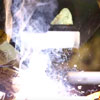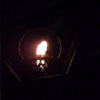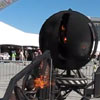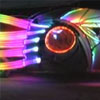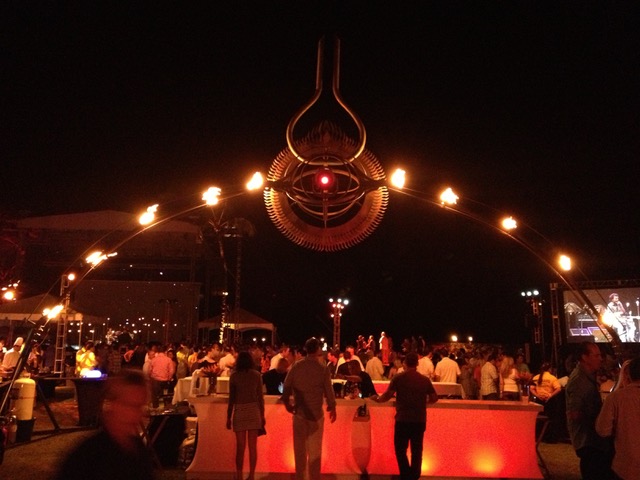
Numinous Eye Arch welcomes guests to Paseo 2019 with multiple fire elements lighting the pathway for the Paseo. This sculpture will be erected with a number of other large fire art pieces Ive built over the years to create a sort of plaza, with the intention of staging an immersive ritualistic sound art experience that would go on for an entire night until dawn
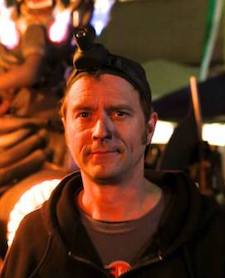
About the Artist
Ryon Gesink has built multiple sculptural fire machines and performed them at numerous events from Hawaii to Detroit. Events include Burning Man, Maker Faire, the Telluride and Breckenridge Fire Festivals, Crucible events, Chabot Space and Science Center, underground events, private showings and many more. Gesink has apprenticed with renowned bronze artist Archie Held in Richmond CA and cut his teeth in steel at Ferrous Studios in Emeryville. He has worked in various capacities at All Power Labs and have collaborated with and/or created pieces for 5 Ton Crane, Orion Fredericks, The Crucible, Keith Hennessy, Deltron 3030, 5Elements Design, Manou Design Group, Five.9 Design, Brian Goggin, AdRoll and many others.
Skills Applied
 WELDING
WELDING
 METAL FABRICATION
METAL FABRICATION
 FLAME TECHNICS
FLAME TECHNICS
Message From The Artist
I have been deeply involved in the metal, machine and fire arts scene in Oakland California for almost 20 years and have had the good fortune to tour my works to many places including Nevada’s Black Rock Desert, Detroit, Colorado, and even Hawaii. Back in 2003, the Numinous Eye presented a very tough build for me. I had become intrigued by the notion of archways and portals and physical passageways demarcating space and creating psychological transition zones. I wanted to capture and frame a piece of sky and earth while appointing a mysterious Watcher of sorts at its apex. There was something very simple and iconic, and some might say demonic! there, as well as a very difficult but worthwhile challenge in the construction.
Doing things beyond what you ever thought you were capable of does give one that feeling of magic. But you still do need to mind the practical demands of gravity and structural integrity of course! To those who may be interested in creating metal and fire arts: My best advice would be to get close to those who are already doing it. Meet them at galleries and events and ask questions, look them up online, talk to me at the Paseo! If you can learn directly from other artists in a volunteer or apprentice situation that is a great way to go. The most important thing is following through and getting past discouragement, it will take time! Years! But if you really want to do it stick with it, most people can master the skills, but you will need persistence and enthusiasm above all. Good luck! Ryon Gesink
STEMarts Design Tool
The Stemarts Design Tool provides a step-by-step tool to help you come up with a design concept for an installation or sculpture inspired by the work of Paseo artists. Explore the artist’s work and theme to understand what makes it unique. Research the science and technology behind the art to inform your design. Then experiment with the related hands-on activities and tools provided in the STEAM wiki to better understand the artist techniques and process. Finally, Brainstorm with your peers to come up with ideas, and create an Installation Design Concept to share with your school. This tool will take you through each stage of the process. Just click on Explore to get started!
Explore fire and motion to design a large scale installation.
Ryon Gesink designs large scale metal sculptures that explore fire and motion for festivals such as Burning man. His work require a knowledge of welding and engineering to create sculptures that are fun and safe for people to interact with. In this activity you will come up with a Design Concept for a large scale installation that explores fire and motion as a medium. The first step is to explore this artist page and STEAM wikis below, and search online, to better understand this genre of art called ‘fire sculpture’ or ‘large scale kinetic sculpture’. Make a note of any installations that you like or do not like. At the end of the exploration review all your selections and reflect on the aspects of the design that you would like to investigate further.
Research the science and technology behind the work.
Once you have honed in on the type of sculpture you would like to design, it is time to dig deeper into how they are made and how they work. Check out the STEAM wiki below to explore some of the basics in welding and engineering large scale installations. What can you learn from these resources and the artist’s process? Even though this project does not require building the installation, it is still important to have an understanding of the materials and technology available in order to design something that is fun and safe.
Brainstorm and experiment to see what’s possible.
Now that you have gotten inspired by all the possibilities you can start brainstorming on ideas for your own large scale kinetic sculpture. Start sketching out concepts and jotting down notes with ideas for an installation. Don’t try to edit at this point. Start a sketchbook just for this project and write or draw anything that comes to mind. This is where you let your imagination run wild!
Get Feedback and iterate.
This is the time to share your concept with peers and experts to get feedback and see how you can improve your design. Practice describing your concept. Discuss and listen to other people’s ideas and remain open to all new possibilities. There will be a lot of trial and error until you arrive at the final design. This stage is especially important to be sure your technical or engineering ideas are feasible. Check our Feedback Tool for some tips.
Create a design concept for an interactive installation.
The next step is to do a final drawing that communicates your design concept for a large scale kinetic sculpture. This could be done by hand or on a computer. The design should show what it will look like and the materials and technology you would use. It would consider possible sites and how people would interact with it. It can include diagrams, text, photos or anything you like. Most importantly it would show how you have created an experience where participants feel connected in some way. Since an installation is multidimensional you will have to find a unique and creative way to communicate your installation concept.
Share your concepts with your classmates and with the visiting artist.
Once all the student drawings are complete they can be displayed in your school. It is fascinating to see the many different ideas and solutions. You can learn a lot by noticing different design approaches and you can share them with the artist when they visit the school. Have fun and don’t forget to share your work with us in the form of photos or videos! We would love to see what you learned.
STEMarts Wiki
The STEAM-wiki is a place to get started with your artist research. You will find links to articles, images, video, and tutorials that relate to Ryon Gesink’s work.
You can search by clicking on the links below or you can click on the topic words in the word cloud for specific areas of interest. For example, FIRE SCULPTURE to see more examples of large scale fire sculptures. If you are looking for STEM + Art activities type in STEAM Activities. To view all options, use the keyword ALL.
Remember the resource is an open forum sharing links and ideas that others have found – always check your sources and give credit where credit is due. The open source movement generously shares its knowledge and relies on user feedback – so if there’s something really good or doesn’t work let others know.
alloys arduino artists art term battery cam chemistry current drawing electric field electricity electric motor engineering experiment fire flame flame physics gas gas metal arc welding installation art interactive art interface iron iron alloy kinetic kinetic sculpture large-scale sculpture lesson magnets materials mechanics metal MIG model molecular structure motion motor motors Paseo artist process project prototyping pyrotechnics robotics science sculpture sensor sensors sound space steel strength structural integrity tutorial View All welding wire


